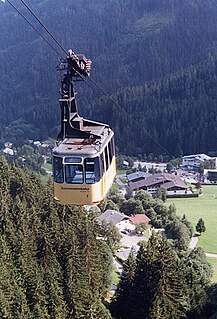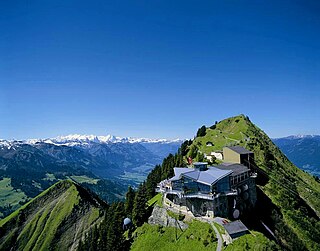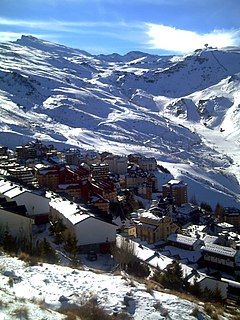Hangursbanen was a cableway in Voss, Norway, 1,126 metres long with a top altitude of 660m above sea level. It was owned and run by Voss Resort AS, a local ski resort in Voss.

An aerial tramway, sky tram,cable car, ropeway or aerial tram is a type of aerial lift which uses one or two stationary ropes for support while a third moving rope provides propulsion. With this form of lift, the grip of an aerial tramway cabin is fixed onto the propulsion rope and cannot be decoupled from it during operations.

Voss (help·info) is a municipality and a traditional district in Hordaland county, Norway. The administrative center of the municipality is the village of Vossevangen. Other villages include Bolstadøyri, Borstrondi, Evanger, Kvitheim, Mjølfjell, Oppheim, Stalheim, and Vinje.

Norway, officially the Kingdom of Norway, is a Nordic country in Northwestern Europe whose territory comprises of the western and northernmost portion of the Scandinavian Peninsula; the remote island of Jan Mayen and the archipelago of Svalbard are also part of the Kingdom of Norway. The Antarctic Peter I Island and the sub-Antarctic Bouvet Island are dependent territories and thus not considered part of the kingdom. Norway also lays claim to a section of Antarctica known as Queen Maud Land.
The cableway starts about 500 metres from the train station at Voss, up to the Hangursrestaurant, which is in the same building as the cable car top station. The cable car operated during winter, the skiing season and in summer.
There were two cable cars on the lines, the Dinglo (red) and the Danglo (blue), on opposite sides, but on the same cable. When one was at the top, the other one was at the bottom. The names come from the swaying from side to side which is "dingling" in Norwegian slang.
Hangursbanen had a maximum speed of 8 m/s. The last journey was on 30 August 2015; the cableway was then disassembled. A new one was built in 2019.

Cable transport is a broad class of transport modes that have cables. They transport passengers and goods, often in vehicles called cable cars. The cable may be driven or passive, and items may be moved by pulling, sliding, sailing, or by drives within the object being moved on cableways. The use of pulleys and balancing of loads moving up and down are common elements of cable transport. They are often used in mountainous areas where cable haulage can overcome large differences in elevation.

A gondola lift is a means of cable transport and type of aerial lift which is supported and propelled by cables from above. It consists of a loop of steel cable that is strung between two stations, sometimes over intermediate supporting towers. The cable is driven by a bullwheel in a terminal, which is typically connected to an engine or electric motor. They are often considered continuous systems since they feature a haul rope which continuously moves and circulates around two terminal stations. Depending on the combination of cables used for support and/or haulage and the type of grip, the capacity, cost, and functionality of a gondola lift will differ dramatically. Because of the proliferation of such systems in the Alpine regions of Europe, the French language name of Télécabine is also used in an English language context.

Zermatt is a municipality in the district of Visp in the German-speaking section of the canton of Valais in Switzerland. It has a population of about 5,800 inhabitants and is classified as a town by the Swiss Federal Statistical Office (FSO).

Les Arcs is a ski resort located in Savoie, France, in the Tarentaise Valley town of Bourg-Saint-Maurice. Initially created by Robert Blanc and Roger Godino, it is a part of the huge Paradiski system which is under ownership by Compagnie des Alpes, a French-listed company owning several other ski resorts as well as theme parks.

La Grave is a commune in the Hautes-Alpes department in southeastern France.

The Table Mountain Aerial Cableway is a cable car transportation system offering visitors a five-minute ride to the top of Table Mountain in Cape Town, South Africa. It is one of Cape Town's most popular tourist attractions with approximately one million people a year using the Cableway. In January 2019, the Cableway welcomed its 28 millionth visitor.

The 3S cable car (Europe), 3S gondola lift and tricable gondola lift (worldwide), or 3S aerial tramway is a cable car system that was developed by the Swiss company Von Roll transport systems in Thun to unite the benefits of a gondola lift with those of a reversible cable car system. ‘3S’ is an abbreviation of the German word dreiseil, meaning ‘tricable’.

Tatranská Lomnica is a town in the Slovak part of the High Tatras mountains. It is a skiing and hiking resort best known for the cable car to Lomnický štít, one of the steepest in Europe and remarkable for its lack of support pylons between the two stations. Tatranská Lomnica railway station is one endpoint of the Tatra Electric Railway, which connects the town to Starý Smokovec.

The Stanserhorn is a mountain in Switzerland, located in the canton of Nidwalden near to the border with Obwalden, with the peak at 1,898 metres (6,227 ft) above sea level.

The Wengen–Männlichen aerial cableway is a cable car linking Wengen with the Männlichen in Switzerland. It is owned and operated by the Luftseilbahn Wengen–Männlichen AG.

Les Diablerets is a village and ski resort located in the municipality of Ormont-Dessus in the canton of Vaud, Switzerland. It is surrounded by the Diablerets Massif, its peak is the highest point in western Switzerland.

The Sierra Nevada Ski Station is a ski resort in the Sierra Nevada in the province of Granada in southeastern Spain. The ski area is on the northwestern slopes of Veleta, the third highest peak in peninsular Spain and the most southerly ski resort of Europe.

The Hintertux Glacier is the tourist name for the glaciers of the Gefrorene-Wand-Kees, also called the Tuxer Ferner, and the nearby Riepenkees at the top of the Tuxertal, a side valley of the Zillertal in the Austrian state of Tyrol. Both glaciers are accessed by gondola and chair lifts and is one of only two ski resorts in the world offering skiing 365 days a year. At its highest point the ski region reaches a height of 3,250 m (10,660 ft) in the saddle between the peaks of the Gefrorene-Wand-Spitzen. Hintertux glacier is one of the most popular glaciers in Austria. It is open all year round with skiing in the winter, and hiking activities in the summer.

The Sugarloaf Cable Car is a cableway in Rio de Janeiro, Brazil. Moving between Praia Vermelha and the Sugarloaf Mountain, it stops at Morro da Urca on its way up and down, and reaches the summit of the 1,299-foot (396 m) mountain.

The Fellhorn Lift is a two-section gondola lift in the German Alps that runs from Birgsautal in Oberstdorf to the peak of the Fellhorn – 1,967 metres above sea level (NN).

Arosa Lenzerheide is a ski area located in Arosa, Lenzerheide, Valbella, Parpan and Churwalden, Graubünden/Switzerland. It originated 2013/14 by connecting the existing ski areas of Arosa and Lenzerheide. With a total of 225 kilometers of ski slopes and 41 cable cars it is the largest contiguous ski area in Graubünden.

Teide Cableway is an aerial tramway that goes up Mount Teide, the highest peak in Spain, located in Teide National Park, Tenerife, Spain. Starting at the bottom station at 2,356 metres (7,730 ft) above sea level, it ascends to the top station at 3,555 metres (11,663 ft) in eight minutes, carrying 44 people per cabin. Conceived in 1929, construction of the cableway was started on 5 September 1963 and was completed on 27 July 1971, starting operations on 2 August 1971. It was renovated between 1999 and 2007.




























